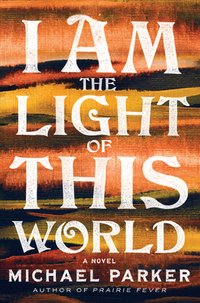I Am the Light of This World by Michael Parker
 Wednesday, November 16, 2022 at 12:06PM
Wednesday, November 16, 2022 at 12:06PM 
Published by Algonquin Books on November 15, 2022
A librarian tells Earl Boudreaux that her mother would like Earl because strange things come out of his mouth. I like I Am the Light of This World for the same reason. Earl is not well educated. He’s not a conventionally deep thinker. He prefers simplicity and yields to uncertainty. He seems to occupy an otherworldly place as an observer who is powerless to affect the course of his drifting life. Yet Earl’s thoughts, which tend to begin with and come back to pedal steel and lessons he finds in Lead Belly’s biography, lead him to ask intriguing questions and make insightful connections.
The story is told in two parts, separated by “the in-between” that spans all the presidents between Carter and Trump. Most of the events described in the first part occur over the course of a few days. Earl is 17, living in Stovall, Texas. His older twin brothers are troublemakers. He has friends with names like Sleepy and Moon, but Earl spends most of his time alone. He likes to sit in the woods and read about Lead Belly. That’s what he’s doing when he meets Tina. She quickly becomes his girlfriend, or at least his sex partner. Tina persuades Earl to drive her to Austin. She says she wants to visit her mother, who has been committed to a psychiatric hospital. As soon as they reach Austin, however, Tina changes the plan. Earl tags along, enjoying the weed that Tina’s friend provides. It's much better than the ditch weed he steals from his brothers.
Unhappy with what he sees Tina doing with the weed supplier, Earl decides to walk to a park that has a swimming pool resembling a pond. He hooks up with two girls who are about his age and with a guy in his mid-twenties named Tom, a man who makes his living selling meth and coke and ludes and weed. The girls are happy to provide sexual favors in exchange for the drugs. Earl finds himself doing the same, although he’s so high after sampling all the drugs he doesn’t quite understand what he’s doing or why he’s doing it. Earl spends the next couple of days and nights in a haze that is fueled by drugs and the absence of sleep.
Earl is at the center of a dramatic event. As he drives back to Stovall, fueled by meth, Earl is arrested and charged with murder. He can’t give a coherent account of his time, although his memories return over the next few days. His lawyer isn’t a legal whiz but he’s a nice guy who understands the odds of a teen with no money or social connections getting a fair trial in East Texas. The prosecutor injects a doubt about Earl’s sexuality to assure that his trial isn’t fair.
In the novel’s second part, the in-between has passed and Earl is drifting again. He makes his way to Oregon, getting off the bus when the moment seems right, and starts a new life in Cliffside. He’s befriended by a librarian and by the librarian’s mother, who rents him a room above her garage. He’s befriended by a swimming instructor who becomes the first person in Stovall to guess some details of his past. He eventually agrees to work on a farm operated by the librarian’s son-in-law. Life is simple but good, the kind of life Earl wants. He seems content, if not happy.
Earl doesn’t want to blame anyone else for his troubles and wonders how he can prepare himself to die if he doesn’t blame himself. Earl has spent decades thinking of himself as a horrible person. The novel’s dramatic question is whether, with the help of supportive people who don’t treat him like trash, he can overcome that self-punishment and achieve a measure of contentment.
While the plot is engaging, the novel’s strength lies in its details. Earl is obsessed by memories of the long telephone cord on his mother’s phone, the transistor radio his father gave him, turnstiles and the negative adjectival. He rambles about those topics when he’s high, yet music is the only subject that Earl can comfortably discuss when he’s straight. He’s not keen on defending the South (Earl is offended by racism), but it’s the only place he’s known until he takes a bus to Oregon. In a discussion of music, he makes the point that jazz, blues, and country music originated in the South. (Rock was certainly influenced by Southern musicians, but Earl probably pushes the argument too far when he claims that rock also originated in the South.) There are so many references to songs I love that the novel seems to come with a soundtrack.
Earl's conversations about music with his lawyer before and during the in-between are one of the few sources of joy in his life. Earl feels his life moving in the syncopated time of music, draped in pedal steel: “There goes your heart, struggling to stay in rhythm and about to bust out all at once.”
I Am the Light of This World is told in the third person, but the narrative voice tracks the kind of language that would be natural to Earl. The narration takes on the rhythm of Earl’s life. For example, “it was hard to say what he was feeling because people did not understand him when he tried. He would say he felt like pedal steel and draw blank faces. He’d say he felt like a midnight train with two lights on behind and the red light was his mind and they would just study his mouth.”
While the story is fundamentally bleak from start to finish, it encourages the reader to root for Earl. Michael Parker makes it possible to understand Earl and even to care about him. Earl has little control over the events that shape his life. He’s not equipped to make good choices. He is nevertheless a compelling character, a young (and then an old) man with whom the reader can easily sympathize. The story seems to offer the hope that new friendships near the end of a life can turn that life around. Although he likely knows that redemptive endings are what book clubs crave, Parker avoids the temptation of a feel-good ending. He tells the story with honesty, compassion, and a good dose of pedal steel.
RECOMMENDED

